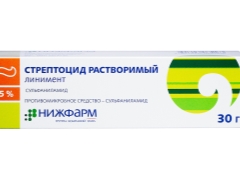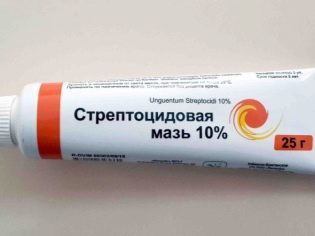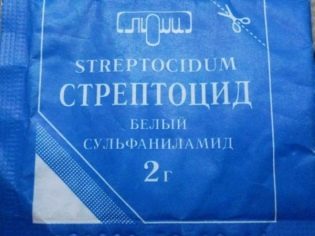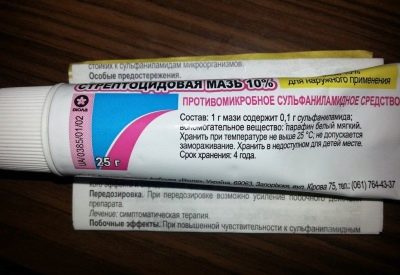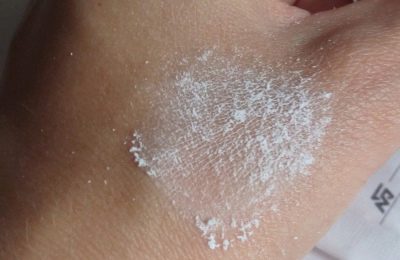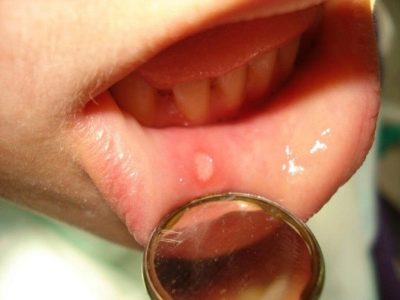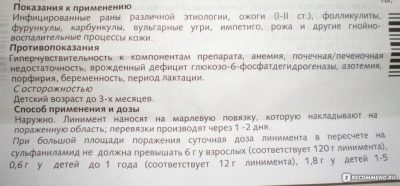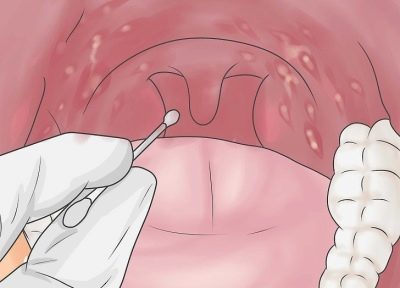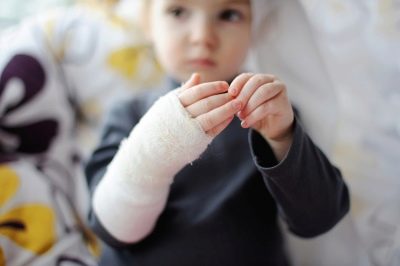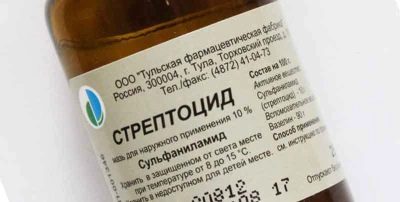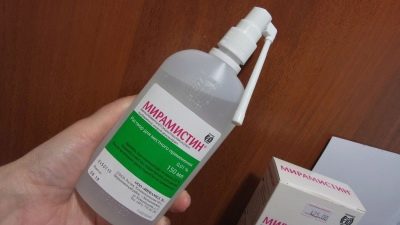Streptocide for children: instructions for use
"Streptocide" refers to antimicrobial drugs from the group of sulfonamides. It is used for adults in the treatment of infected wounds, acne, tonsillitis and other diseases. But is it possible to use such a medicine in childhood?
Release form and composition
Now in pharmacies you can find several versions of the drug, which differ only in name. The difference between them is the manufacturer and form of release. These include Streptocid, Streptocid Ointment, and Streptocid Soluble. All of them as the active ingredient contain the same substance.
In Russia, the drug is presented in three forms.
- 10% ointment. This tool in the form of a uniform white or yellow thick mass is produced in glass jars or tubes of aluminum. In one pack is 25 or 50 g of the drug.
- 5% liniment. This form of the drug is called "Streptocid soluble" and is a thin uniform cream or white mass, packed in aluminum tubes or glass jars of 30 g each.
- Powderwhich is used for external processing. It is sold in portion bags containing 2 or 5 g of the drug.
Previously, Streptocid was represented by two more forms - tablets and powder, from which an intravenous injection solution was made. Now, domestic companies are not releasing these types of drugs, since they have been replaced by more effective means, such as sulfonamides and antibiotics of different groups.
Composition
The main component of all forms of "Streptocide" is a substance called sulfanilamide. As part of the liniment, it is presented in a soluble form, so its name is different. In this form, the active component is mesulfamide.
In the powder, in addition to the active compound, there are no other components, so the dosage of the drug in this form corresponds to the amount of the powder. Since the ointment is 10%, then 100 grams of this drug contains 10 g of sulfanilamide. The content of mesulfamide in liniment is 5 g / 100 g, which gives a 5% concentration of the finished product. In the composition of the ointment, petrolatum is added to the active substance, and the auxiliary components of liniment are glycerol, purified water and emulsifier.
Operating principle
The drug has an antimicrobial effect, due to which Streptocid destroys pathogenic bacteria, provoking an inflammatory process in various organs. The drug prevents the growth and reproduction of harmful bacteria, as it can suppress the formation of substances without which the synthesis of RNA and DNA of microbial cells is impossible.
The medicine has a detrimental effect on various types of cocci, including gonococcus, meningococcus, pneumococcus, streptococcus, and other globular bacteria. Streptocide also affects the reproduction of Escherichia coli, Vibrio cholera, Clostridium, Corynebacterium, Diphtheria, Shigella, Chlamydia, Toxoplasma and other microorganisms. In addition to the antimicrobial effect, Streptocid has some anti-inflammatory effect, as well as accelerates the healing of skin lesions.
Indications
Given the therapeutic effect of Streptocide, it is in demand in the treatment of diseases such as:
- tonsillitis;
- stomatitis;
- infected wounds;
- furuncles, pyoderma, folliculitis and other bacterial infections of the skin;
- cracks in the skin;
- corns;
- surgical incisions;
- erysipelas;
- diaper rash;
- first or second degree burns;
- ulcerative lesions of the skin.
From what age is prescribed?
In the treatment of children, Streptocid soluble is most often used, since the form of liniment is allowed from 3 months of age. Due to the higher dosage of sulfonamide powder and ointment prescribed for children over 3 years.
Contraindications
Use Streptocid is not possible for the following diseases:
- hypersensitivity;
- anemia;
- porphyrias;
- severe kidney disease;
- thyrotoxicosis;
- azotemia;
- liver failure;
- blood formation disorders;
- deficiency of glucose-6-phosphate dehydrogenase.
Side effects
"Streptocid" may cause an allergic reaction, such as urticaria. If the drug is used over a large area, sulfanilamide can be absorbed into the bloodstream, leading to nausea, headaches, belching, diarrhea, cyanosis, and other symptoms.
When they occur, you should refuse further treatment and consult with your doctor.
Instructions for use
The preparation in the form of a powder is applied to the skin by dusting or using gauze. It can be applied immediately to a wound or other damage. The drug should be evenly distributed over the surface. The treated surface can be left open or covered with a gauze bandage. For one treatment, one sachet is used — these are 2–5 g of medicine, depending on the area of the lesion.
The drug is applied to the skin three or four times a day, taking into account the course of the disease. When a weeping wound, Streptocid is used more often, and if there is practically no discharge, it is enough to sprinkle the skin at the wound site only 1-2 times a day.
Some doctors prescribe the drug and with a cold or sinus, including "Streptocid" in the prescription of complex nose drops. For pains in the throat and cough caused by pharyngitis, sore throat, mouth sores and so on, the powder can be used in three ways, namely:
- dusting the tonsils with a cotton swab every 2 hours;
- it can be kept in the mouth until it is completely absorbed 2-3 times a day, and since the drug is bitter, it is mixed with honey;
- the powder is dissolved in warm water (2 g per cup) and gargling is done every two hours.
The drug in the form of liniment or ointment is applied to the desired area of the skin directly from a tube or using a napkin 1-2 times a day. This form of Streptocide is used until the moment when inflammatory fluid or pus is no longer released from the damaged skin. If medication is prescribed at angina or stomatitis, then the inflamed area of the mucous membrane is treated with liniment 2-3 times a day.
When the lesions are quite extensive, it is important to remember the maximum amount of the drug per day, namely:
- The skin of a child up to one year in 24 hours can be smeared with no more than 12 grams of liniment (the permissible amount of sulfanilamide is 0.6 g);
- for children from 1 to 5 years old, it is permissible to use no more than 1.8 g of the active substance, that is, the skin can be lubricated with a maximum of 36 grams of liniment during the day, and at 3-5 years old - 18 grams of ointment;
- a child over 5 years old can receive no more than 3 grams of sulfanilamide, which will correspond to 30 g of ointment, and if liniment is used, then in an amount of not more than 60 g
On average, ointment and liniment is applied in a course of 10-14 days, but if necessary, the doctor may prescribe a longer treatment.
Overdose
If you use the drug in a significant amount or a long period of its active substance will flow into the blood in large quantities, it will lead to dyspepsia, headache, drowsiness, fever and other negative symptoms. If a child accidentally swallows any of the forms of Streptocide, gastric lavage and abundant alkaline drinking are indicated.
Drug interaction
When treating a large surface of the skin, Streptocid is able to enhance the side effects of hematotoxic drugs that adversely affect the blood system.Treatment with Streptocide after lubrication of the skin with Novocain will reduce the therapeutic effect of the drug, therefore an interval of at least 30 minutes is recommended between the use of such drugs.
It is not recommended to combine the treatment with Streptocide and the use of drugs that include phenylephrine, caffeine, phenobarbital and some other active substances.
Purchase and storage
Streptocid is sold without a prescription. One packet of powder costs about 30 rubles, and a package of ointment or liniment costs 60–80 rubles. Store the medicine at home is recommended at room temperature in a dry place.
The shelf life of liniment is 4 years, ointment and powder - 5 years.
Reviews
On the use of "Streptocide" there are mostly good reviews. In them, the drug is praised for its effectiveness, low cost and a wide range of applications. According to moms, this medicine quickly heals various injuries, preventing the appearance of suppuration or scarring.
Analogs
Instead of "Streptocide" for skin lesions, other antimicrobial or antiseptic topical agents can be used, for example, "Miramistin», «Baneocin», «Levomekol», «Betadine», «Hyoxyson" other. It is necessary to choose analog together with the doctor.
The use of streptocide in adults and children can be found in the following video.
